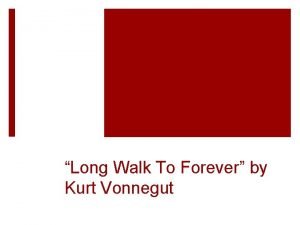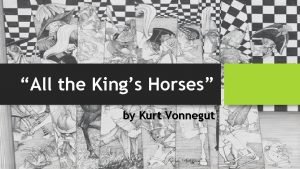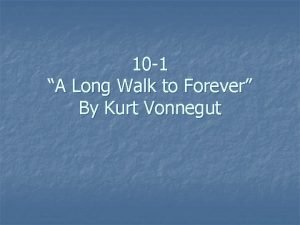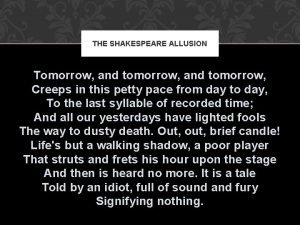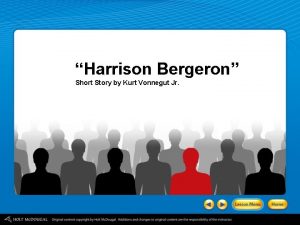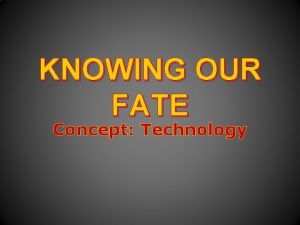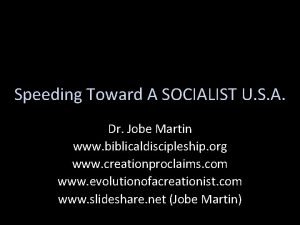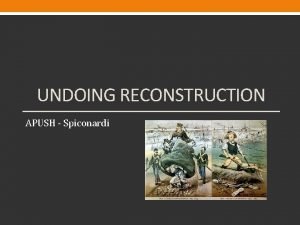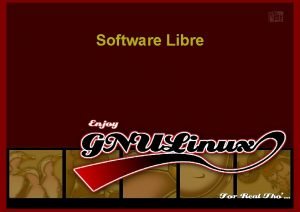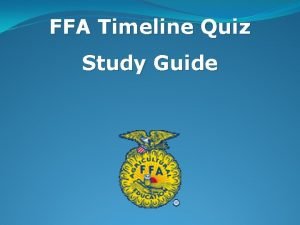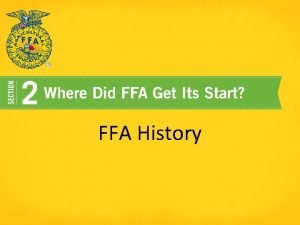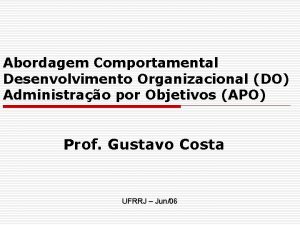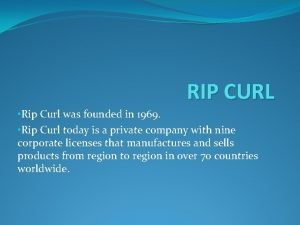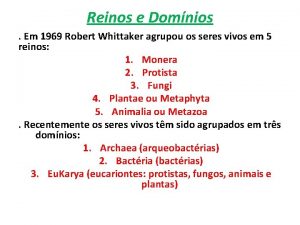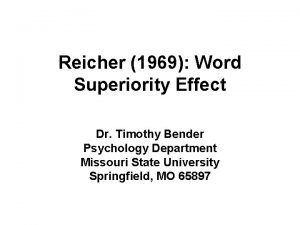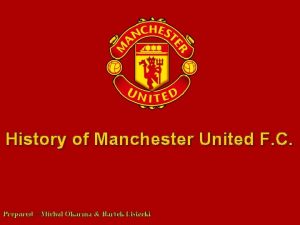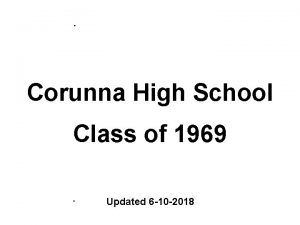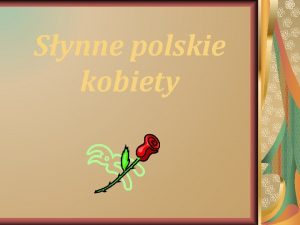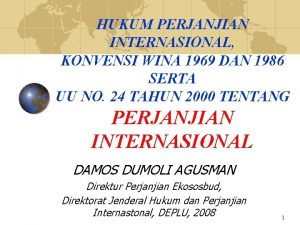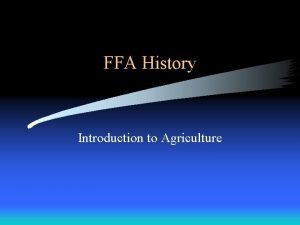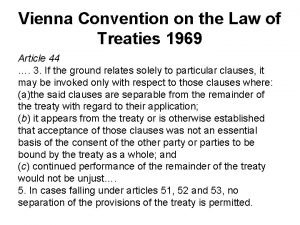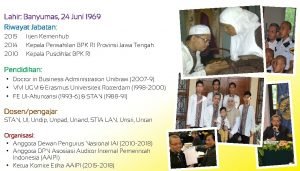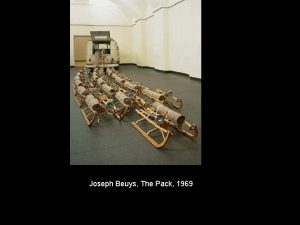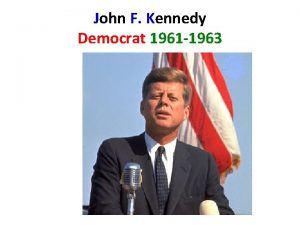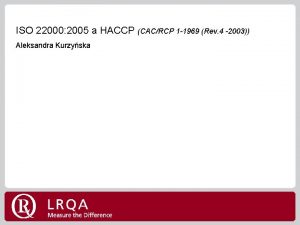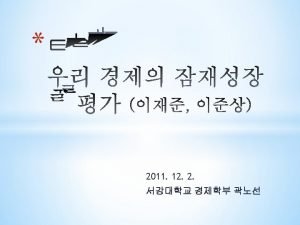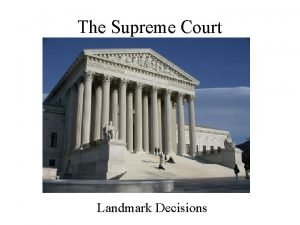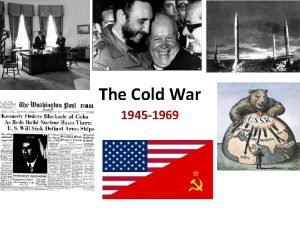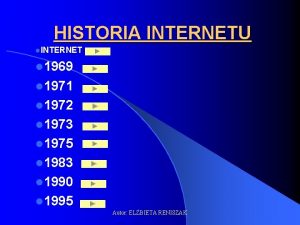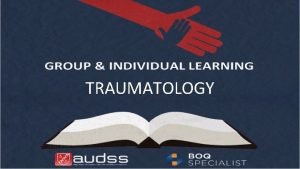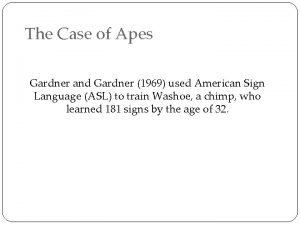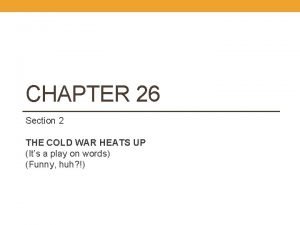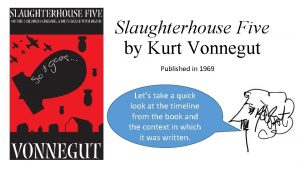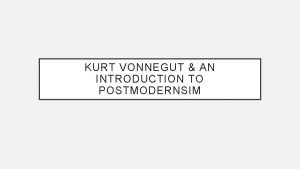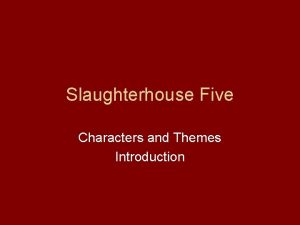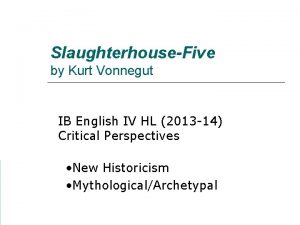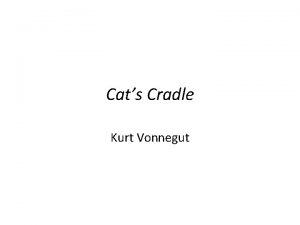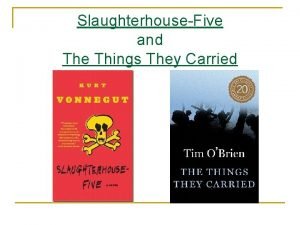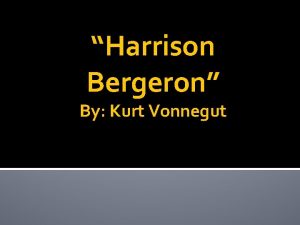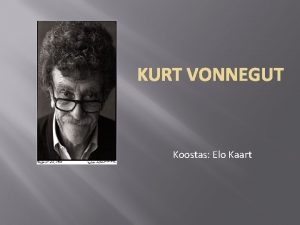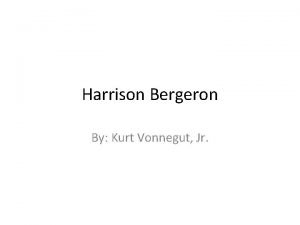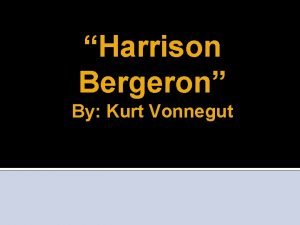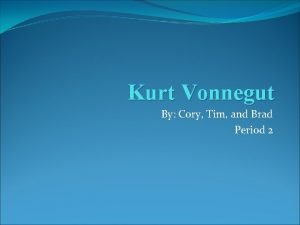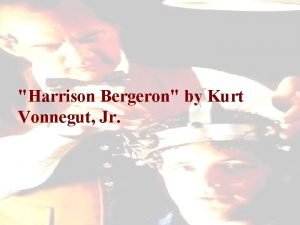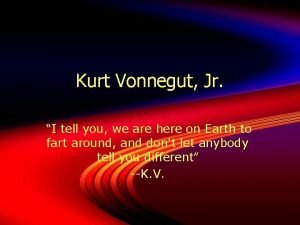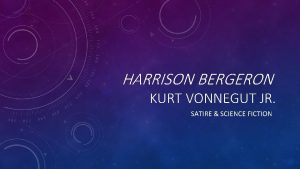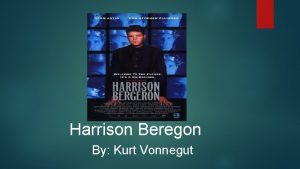SlaughterhouseFive Kurt Vonnegut Jr Slaughterhouse Five 1969 One














































- Slides: 46

Slaughterhouse-Five Kurt Vonnegut, Jr.

Slaughterhouse Five 1969 One of his most popular works and widely regarded as a classic, it combines science fiction elements with an analysis of the human condition from an uncommon perspective, using time travel as a plot device. n The bombing of Dresden in WWII, the aftermath of which Vonnegut witnessed, is the starting point. n Among the most frequently banned works n

Bombing of Dresden British Royal Air Force (RAF) and United States Army Air Force (USAAF) between February 13 and 15 th, 1945

Vonnegut and the war (From the NY Times) n n (Vonnegut) was accorded the dubious pleasure of witnessing a 20 th-century apocalypse During World War II, at the age of 23, he was captured by the Germans and imprisoned beneath the city of Dresden, "the Florence of the Elbe. " Allies firebombed Dresden in a massive air attack that killed 130, 000 people and destroyed a landmark of no military significance Slideshow: http: //www. fpp. co. uk/overflow/Dresden_gallery/

Literary Techniques • The novel employs the refrain "So it goes" • As a representative postmodern text, the novel is metafictional. • Non-linear plot structure • Verisimilitude– soldiers’ cursing • irreverent language (including the sentence "The gun made a ripping sound like the opening of the zipper on the fly of God Almighty, ")

Non-linear structure • The story is told out of order but there are only three decades through which the narrative (and Billy) jumps: – 1940’s The War. This is the only segment that moves consistently forward through time…even as it is interrupted. – 1950’s post war. Billy’s wife and career – 1960’s/ Fourth Dimension…

Metafiction • fiction that self-consciously addresses the devices of fiction. • It is the literary term describing fictional writing that self-consciously and systematically draws attention to its status as an artifact in posing questions about the relationship between fiction and reality, usually, irony and self-reflection.

Other postmodern weirdness • The story is sandwiched between an autobiographical introduction and epilogue…this sets up further uses of metafiction • The Narrator/ Author divide is blurred

The World of Vonnegut n n Kilgore Trout, a major character in many of Vonnegut's novels, appears significantly in Slaughterhouse-Five. He is not real, but I have a copy of one of his novels over there. cameo appearances include Eliot Rosewater of God Bless You Mr. Rosewater Howard W. Campbell, Jr. of Mother Night. There is also a character called Bertram Copeland Rumfoord, a relative of Winston Niles Rumfoord in The Sirens of Titan. Rumfoord family members appear in several of Vonnegut's works

NY Times review, 1969: n In the … introduction, which should be read aloud to children, cadets and basic trainees, Mr. Vonnegut pronounces his book a failure "because there is nothing intelligent to say about a massacre. " He's wrong and he knows it.

Respond to the following quote: “Hello, babies. Welcome to Earth. It’s hot in the summer and cold in the winter. It’s round and wet and crowded. At the outside, babies, you’ve got about a hundred years here. There’s only one rule that I know of, babies – ‘God Damn it, you’ve got to be kind. ’ ”

Quotation Response • What does this quotation mean to you? • If you could rewrite the last sentence, what would it be? • What rule would you give to future generations?


Kurt Vonnegut “And so it goes. ” 1922 -2007

http: //www. fpp. co. uk/overflow/Dresden_gallery/

John Wayne Frank Sinatra

Tralfamadore • Exists in the Fourth Dimension • Tralfamadorians can see all time at once • Think the idea of free will is ridiculous • Not related to Billy being unstuck in time

Fourth Dimension

In this Power Point, when I talk about n STYLE terms will be yellow n THEME will be red

LITERARY TERMS-- Style LITERARY TERMS YOU SHOULD KNOW n Point of View (handout) n Tone (handout) n Imagery n Surrealism n Stream of Consciousness ______ n THEME (not style)

Two areas of study: STYLE and THEME n STYLE refers to Formal aspects of the story; how the story is told. Deals with Point of View, Plot Structure, Tone, Imagery, etc. (Modernism experiments with style. ) n THEME refers to ideas or truths about life. (These are also specifically Modern. )

IMAGERY (Copy into notebook) A word or group of words in a literary work which appeal to one or more of the senses: sight, taste, touch, hearing, and smell. The use of images serves to intensify the impact of the work.

denotation a literal meaning of the word connotation an association (emotional or otherwise) which the word evokes n For example, both "woman" and "chick" have the denotation "adult female" in North American society, but "chick" has somewhat negative connotations, while "woman" is neutral.

For another example of connotations, consider the following: n negative • There are over 2, 000 vagrants in the city. n neutral • There are over 2, 000 people with no fixed address in the city. n positive • There are over 2, 000 homeless in the city.

stream of consciousness n n a narrative mode that seeks to portray an individual's point of view by giving the written equivalent of the character's thought processes: a loose interior monologue, characterized by associative leaps in syntax and punctuation that can make the prose difficult to follow. often depicted as overheard in the mind (or addressed to oneself) or in connection to his or her actions.

STYLE • Refrain– “so it goes” • “Point-connection” • Diction– earthling massacre babies • Motifs—like themes or ideas that keep popping up

Recurring motifs/ imagery/refrains n n p. 4: "mustard gas and roses"; the phrase is repeated in other places in Sh-5. I think this page has the first use of "babies"; note that word and its cognates— babies are important in Sh-5. Note "And so on" and "Three Musketeers" (here, the candy bar); these phrases also recur in Sh-5. pp. 28 -29: Note the "blue and ivory" of Billy Pilgrim's feet; the colors are another motif in Sh-5.

Weary’s Version of the War Story: The Three Musketeer’s Anyone remember where we first heard that name?

Princess

Tone The writer’s or speaker’s attitude toward the subject and the audience. Understanding tone is crucial to understanding the author’s meaning

boyfriend/girlfriend, a pair of spies, a parent and child, etc. : A: You’re late! B: I know. I couldn’t help it. A: I understand. B: I knew you would. A: I have something for you. B: Really? What? A: This!

Diction: the author’s choice of words and their connotations (the suggested meanings of the words) Details: the bits of information the author uses to tell the reader about setting, character, etc. Images: details that appeal to the senses Language: the overall quality of language in a work (formal, scientific, casual, etc. ) Syntax: the construction of the sentences in a work (short, medium, long; simple, complex; etc. )

Tone is described with an adjective. Here are some Sentimental Fanciful Complimentary Condescending Sympathetic Contemptuous Apologetic Humorous Horrific Sarcastic Nostalgic Zealous Irreverent Benevolent Seductive Candid Pitiful Didactic

Syntax / Diction/ Language And on and on it went that duet between the dumb, praying lady and the big, hollow man who was so full of loving echoes. n n --Chapter Six n How does KV feel about Billy’s mom and Rosewater? How does he seem to feel about us? Does he hold back? Assume we’re sympathetic to him? To the characters? How does he feel about the

THEME n The main idea or underlying meaning of a literary work. A theme may be stated or implied. Theme differs from the subject or topic of a literary work in that it involves a statement or opinion about the topic. Not every literary work has a theme. Themes may be major or minor. A major theme is an idea the author returns to time and again. It becomes one of the most important ideas in the story. Minor themes are ideas that may appear from time to time.

Theme vs. Subject n n It is important to recognize the difference between theme of a literary work and the subject of a literary work. The subject is the topic on which an author has chosen to write. The theme, however, makes some statement about or expresses some opinion on that topic. For example, the subject of a story might be war while theme might be the idea that war is useless.

Four ways in which an author can express themes are as follows: NUMBER ONE Themes are expressed and emphasized by the way the author makes us feel. . By sharing feelings of the main character you also share the ideas that go through his mind n

Number TWO n Themes are presented in thoughts and conversations. Authors put words in their character’s mouths only for good reasons. One of these is to develop a story’s themes. The things a person says are much on their mind. Look for thoughts that are repeated throughout the story.

Number THREE n Themes are suggested through the characters. The main character usually illustrates the most important theme of the story. A good way to get at this theme is to ask yourself the question, what does the main character learn in the course of the story?

NUMBER FOUR n The actions or events in the story are used to suggest theme. People naturally express ideas and feelings through their actions. One thing authors think about is what an action will "say". In other words, how will the action express an idea or theme?

Machines/ Technology…So it goes. § “I have told them not to work for companies § § which make massacre machinery, and to express contempt for people who think we need machinery like that. ” (19; ch. 1) The elevator – kills the Veteran (senseless death) The Photograph – the porn arrest leads to senseless death Weary– iron maiden, triple-blade knife, the cannon Oh, and planes dropping bombs on Dresden

Time § P. 18 “And I asked myself about the present: how wide it was, how deep it was, how much of it was mine to keep. ” § P. 20 “As an earthling, I had to believe whatever clocks said– and calendars. ” § “it was written by a pillar of salt. ” § Billy is unstuck in time. § Tralfamadorians

Children/ innocence § Children’s crusade § Mary O’Hare § Adam and Eve

Perception § Optometry § Tralfamadorians § Roland Weary’s version of the war story § Sinatra and Wayne

More to come: § REVENGE § CHRISTIANITY ( hypocrisy of some of them)

n “Stupid, Roland Weary fat, and mean” n Dad collected torture devices n Brought his own knife to the war n Hates being ditched
 Theme of long walk to forever
Theme of long walk to forever Kurt vonnegut all the king's horses
Kurt vonnegut all the king's horses The long walk to forever
The long walk to forever Tomorrow and tomorrow creeps in this petty pace
Tomorrow and tomorrow creeps in this petty pace Harrison bergeron plot
Harrison bergeron plot Harrison bergeron summary
Harrison bergeron summary Tomorrow and tomorrow and tomorrow kurt vonnegut analysis
Tomorrow and tomorrow and tomorrow kurt vonnegut analysis Nehemiah institute peers test
Nehemiah institute peers test Apush sharecropping
Apush sharecropping What is being satirized in harrison bergeron
What is being satirized in harrison bergeron Walter gropius (1883-1969)
Walter gropius (1883-1969) 1969 white paper
1969 white paper Jane mixer
Jane mixer Sistemas unix
Sistemas unix Ffa unit study guide
Ffa unit study guide Dr charles homer lane
Dr charles homer lane Beckhard 1969 desenvolvimento organizacional
Beckhard 1969 desenvolvimento organizacional Theodorson and theodorson 1969 communication
Theodorson and theodorson 1969 communication Rip curl 1969
Rip curl 1969 Whittaker 1969
Whittaker 1969 Reicher 1969
Reicher 1969 Interface between user and hardware
Interface between user and hardware Fc united of manchester wiki
Fc united of manchester wiki 1969
1969 Skrombotoksin
Skrombotoksin Grażyna skrzypaczka zm.1969 r
Grażyna skrzypaczka zm.1969 r Wina 1969
Wina 1969 Important dates in ffa history
Important dates in ffa history 1966 1967 1968 1969 1970 1971 1972 1973 1974 1975
1966 1967 1968 1969 1970 1971 1972 1973 1974 1975 Vclt 1969
Vclt 1969 July 1969
July 1969 Matriz bcg natura cosmeticos
Matriz bcg natura cosmeticos 24 juni 1969
24 juni 1969 Joseph beuys how to explain pictures to a dead hare
Joseph beuys how to explain pictures to a dead hare Lyndon b johnson 1969
Lyndon b johnson 1969 Cac/rcp 1-1969 rev 5 2020
Cac/rcp 1-1969 rev 5 2020 International health regulation adalah
International health regulation adalah Oms 1969
Oms 1969 Branch expansion programme and policy
Branch expansion programme and policy 1969 1970 1971 1972 1973 1974 1975 1976 1977 1978
1969 1970 1971 1972 1973 1974 1975 1976 1977 1978 Miranda warning
Miranda warning The cold war heats up: 1945 - 1969
The cold war heats up: 1945 - 1969 Historia internetu prezentacja
Historia internetu prezentacja Copyright regulations 1969
Copyright regulations 1969 Vanavar bush
Vanavar bush Gardner and gardner 1969
Gardner and gardner 1969 Chapter 26 section 2: the cold war heats up answer key
Chapter 26 section 2: the cold war heats up answer key
